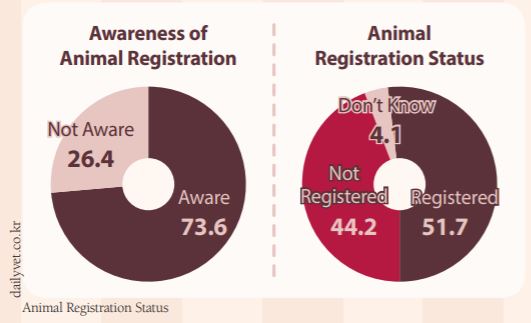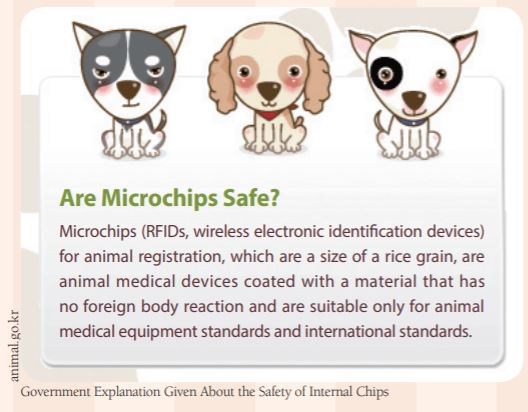The animal registration system was implemented for the first time in 2014 to prevent lost or abandoned dogs. Five years have already passed since the animal registration system was mandated. Since 2014, it has been estimated that only 50.2 percent of about 5.11 million households with dogs registered in 2018. The rate keeps increasing, but there is still a long way to go to reach the status of “full registration”. The government has announced that it will strengthen and enforce a crackdown starting from September after the voluntary reporting period until the end of August. The Sungkyun Times (SKT) now takes a look at the animal registration system.
What Is the Animal Registration System?
Concept and Background of the Animal Registration System

Animal registraion is a law designed to protect abandoned animals as the number of abandoned dogs keeps increasing. It is a system that requires dog owners who own dogs that are more than three months old to register them. It had been implemented selectively since 2008, then expanded through the entire country in 2013 and became mandatory from January 1st, 2014. A two-month voluntary reporting period will be given from July 1st to the end of August, and if not registered, a fine of less than 1 million won will be imposed starting from September 1st.
How to Register
Pet registration must be done within 30 days from the day the dog reaches three months’ and can be registered through the city, county, ward office and registration agency nearby. There are three ways to register dogs: an internal chip, an external chip, and an identification tag. An internal chip is a method of inserting a small microchip into a dog’s body in the form of an injection. External chips and recognition tags are little chips and name tags that are attached to the outer body. If any changes occur after registration, changes can be reported. The owner must report the change when the owner’s information has changed, when an animal is lost, when the lost animal is found again, when the registered animal dies, or when the identification device or registration recognition tag is lost or misused.
Problems of the Animal Registration System
Controversy over Internal Chips of the Animal Registration System
The internal chip is an animal medical device that is the size of a rice grain. Some dog owners tend to have a bad perception of putting internal chips inside their dogs since pets are considered as friends and family nowadays. Moreover, the anxiety of the side effects that might occur increases the negative perceptions of the dog owners. However, contrary to the concerns of people, only 14 out of 180,201 cases involving microchips were reported to have side effects, which are very unlikely to occur, according to the Ministry for Food, Agriculture, Forestry and Fisheries. Nevertheless, the dog owners’ concerns don’t seem to get weaker due to a lack of proper explanation and publicity of the safety of internal chips and the small possibility of side effects that cannot be ruled out completely.

Lack of Effectiveness of the Animal Registration System
Although not registering pets means a pet owner can be subject to fines, there is no actual crackdown happening at present. The crackdown is supposed to be done by patrolling around and inspecting, but due to the lack of public officers the crackdown is barely happening. Only one given fine recorded in the past six years since 2014 proves it. In addition, it is difficult to track if an owner who has crossed between cities or provinces has violated the law before or not. Therefore, if dog owners ignore the first warning and cross borders of districts, they will only get more warnings with no fine. Also, there is a controversy over the effectiveness of registered pets as, except for the internal chip method, they can be disposed of easily if the owner decides to do so. It shows that the law is not performing the purpose of the legislation very well which is to prevent dogs from being abandoned.
The Orientation of the Animal Registration System
Reaching the “full registration” status is the first priority in order for the law to work properly. To accomplish the goal, promoting the contents of the system itself, as well as the practical publicity of the benefits of the registration system that can be recognized and felt by the dog owners is necessary. It is crucial to increase the general awareness of the law by far. In addition, substantial and specific solutions are needed to increase the enrollment rate. It is an effective way to encourage participation through specific incentive methods such as allowing only registered dogs into pet parks. Another way to take responsibility for the future registration rate is to register dogs at the same time as selling. Also, methods that give the unregistered dogs’ owners penalties such as banning unregistered animals from treatment at the animal hospital can be a powerful and effective way as well.
It is no exaggeration to say that our society is where we live with dogs together. However, the problem of abandoned dogs is a big social problem, as it takes more than 10 billion won each year to deal with 80,000 lost and abandoned animals. The registration of pets is a positive step in the formation of animal welfare culture and social cost reduction. For the law to be implemented practically and effectively, however, the government and local governments need to work hard and implement continuous policies to ensure the culture of pets is established.
